History of the Nile’s Riverbanks
The Nile River is not only the longest river in the world, but also a cradle of civilization that has shaped the destinies of societies since ancient times. Its banks have witnessed the rise and fall of empires. Served as the birthplace for remarkable cultures, and inspired countless works of art, including the famous folk ballad ‘Banks of the Nile’. In this article, we will traverse the rich and storied history of the Nile’s riverbanks. Uncovering their significance in shaping human history.
The Nile Significance in Ancient Egypt
The banks of the Nile have been the lifeblood of Egypt for thousands of years. The river’s predictable flooding cycle deposited nutrient-rich silt onto its banks. Creating fertile land that supported the agricultural foundation of ancient Egyptian civilization.
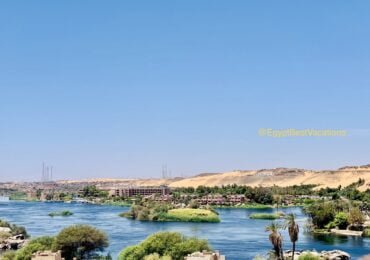
A Haven for Agriculture
Farming communities settled along the banks of the Nile as early as 5000 BCE, cultivating grains, vegetables, and fruits. The Egyptians ingeniously devised irrigation systems to harness the waters of the Nile. Allowing them to grow surplus crops and support a rapidly growing population.
The Emergence of Mighty Cities
Cities like Thebes and Memphis rose along the banks of the Nile, becoming centers of political power, trade, and cultural development. They served as hubs where people gathered to worship, conduct business, and participate in communal activities.
Memphis was the first capital city of United ancient Egypt. It was located 20 km south of modern Cairo, near the apex of the Delta. It was established in 3200 BC. By the first king of the unified Egypt, Menes or Narmer. Memphis was recurrently the administrative center of the politically unified state of Egypt in Pharaonic times.
Thebes (modern Luxor) emerges as a captivating city that stands as a living museum, a repository of the grandeur of ancient Egypt. Emerged around the 11th Dynasty, circa 2000 BCE, Thebes became a cultural and economic hub. Strategically positioned at the crossroads of trade and intellectual exchange. Luxor, its modern successor, proudly carries forward the torch of this ancient legacy.
The Nile as a Cultural and Spiritual Symbol
The riverbanks of the Nile also held a deep spiritual significance for ancient Egyptians. The Nile was revered as a god, Hapi, who was believed to control the flooding of the river. Hapi was always represented as a man with female breast with Lotus and Papyrus flowers on top of his head. Lotus flower to represent Upper Egypt (south) while Papyrus to represent Lower Egypt (north). The word (Nile) is derived from the Greek (Nilos) which means the riverbanks.
The Heartbeat of Mythology and Religion
Egyptian mythology is rich with stories and gods connected to the river. The annual flooding of the Nile was celebrated with huge celebrations at the temples and public areas. Wafaa El-Nile, a tradition that continues to this day. Temples and monuments built along the riverbanks, such as Karnak Temple and Luxor Temple, still stand as testament to river’s revered status.
Karnak Temple complex was the great god’s chief sanctuary and much larger than any other monument in Egypt. This huge complex which actually contains many separate temples covers 1700 years of expansion and an area of 300 acres. The Karnak Temple continues to stand as a remarkable testament to the religious and artistic achievements of ancient Egyptian civilization.
Luxor Temple was built by the pharaoh Amenhotep III (1387-1349 BCE), the grandson of the military genius Tuthmosis III. It was expanded by the 19th Dynasty pharaoh Ramses II (1279-1213 BCE). Numerous other sovereigns, including Tutankhamun, Horemhab, and Alexander the Great enriched the construction with reliefs, inscriptions, and minor buildings.
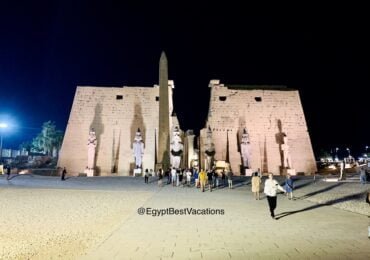
Burial Grounds of Kings and Nobles
The west bank of the Nile was associated with the afterlife. Leading to the construction of elaborate tombs and mortuary temples. Valley of the Kings, Valley of the Queens and Hatshepsut Temple are very great examples. The location of these burial sites was no coincidence. As the setting sun in the west symbolized the journey of the dead into the afterlife.
Valley of the Kings is the necropolis of the great Egyptian pharaohs of the 18th to the 20th Dynasty (1550-1080 BCE). Tuthmosis I was the first pharaoh who was buried at the Valley of the Kings. While Ramses XI was the last pharaoh who was buried there. While Valley of the Queens is a necropolis dedicated to royal wives and children of the 19th Dynasty onward.
Hatshepsut Temple is situated against the cliffs of Deir el-Bahari, this imposing monument reveals the captivating tale of one of Egypt’s extraordinary female pharaohs. The mortuary Temple of Hatshepsut is one of many archaeological UNESCO World Heritage sites.
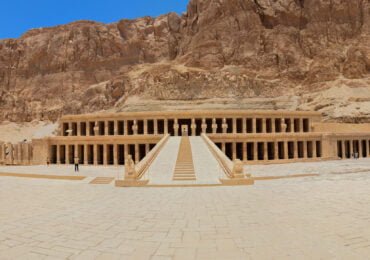
The Nile’s Role in Trade and Transportation
The banks of the Nile have always been a major thoroughfare for trade and transport. Ancient Egyptians used the river to move goods and people, with sailing vessels carrying commodities like gold, papyrus, and grain along the length of Egypt.
A Highway for Commerce
Trade expeditions traveled beyond Egypt’s borders, navigating the Nile to reach far-flung regions. The river facilitated exchange with other African kingdoms, the Middle East, and the Mediterranean world.
The River as a Strategic Asset
Control over the Nile’s riverbanks was crucial for maintaining economic and military strength. Throughout history of Egypt, rulers who dominated the Nile’s banks had a strategic advantage over their adversaries due to their contro; over the vital waterway.
The Banks of the Nile in Modern Times
In contemporary times, the banks of the Nile continue to be focal point for Egypt’s economy, culture, and tourism.
Agriculture and Industry
Modern irrigation and damming projects, such as the Aswan High Dam, have transformed the riverbanks into year-round agricultural lands and power generation sites. However, these developments have also raised concerns about ecological impacts and the displacements of communities.
The Aswan High Dam, like many other projects, has consequences. Some environmental issues include the displacement of 150, 000 Nubians in other cities, 100,000 in Egypt, and 50,000 in Sudan. Because of the accumulation of silt and minerals in the lake, the Egyptian soil has become less fertile, necessitating the use of chemical fertilizers. 22 temples including Philae and Abu Simbel Temples, were dismantled and rebuilt in other places to rescue them from water.
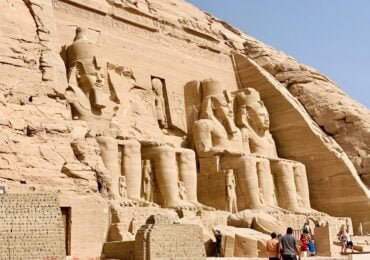
Tourism and Heritage
The banks of the Nile are home to some of the world’s most iconic historical sites, attracting millions of tourists annually. Nile cruises along the river offer a unique perspective on the ancient monuments and the vibrant life that still flourishes on the riverbanks.
Egypt Best Vacations is happy to provide you with the best River Nile cruises in Egypt. Select your favorite type of our magnificent selection of Egypt River Nile cruises. Choose between large Nile cruise ships, or elegant Dahabiya cruises or adventurous Felucca cruises.
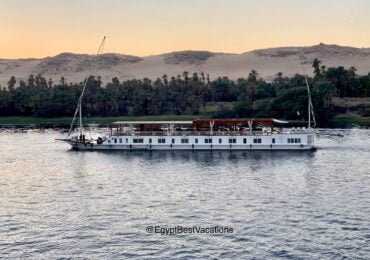
The Folklore: Fotheringay and ‘Banks of the Nile’
The Nile’s riverbanks have inspired countless tales and songs, including the English folk ballad ‘Banks of the Nile’, performed by the band Fotheringay in the 1970s. The song reflects the timeless allure of the Nile and the sorrow of parting lovers, a theme that resonates with the river’s history of being a place of both connection and separation.
Emotional Resonance in Music
The song’s melancholic lyrics and haunting melodies capture the emotional depth associated with the Nile’s bank. It’s a reminder of how the river has not only shaped the physical landscape but also the human part.
A Symbol of Love and Loss
Throughout Egypt’s history, the bank of the Nile have been a backdrop for countless human stories of love, loss, and longing. ‘Banks of the Nile’ echoes these sentiments, bridging the gap between the past and the present through its moving narrative.
Preserving the Banks of the Nile for Future Generations
The history of the Nile’s riverbanks is a treasure that must be preserved. Efforts to protect the river’s cultural heritage and natural environment are critical for ensuring that future generations can appreciate and learn from this magnificent river.
Initiatives to restore historical sites and protect the river’s ecosystem are underway, with international collaboration playing a key role in these endeavors. Educational programs aim to raise awareness about the importance of the Nile and its banks, encouraging local communities and visitors to become stewards of this precious resource.
Conclusion
The banks of the Nile have a history as deep and flowing as the river itself. From the agricultural revolution that spurred the rise of ancient Egypt to the modern challenges of conservation, the riverbanks have been a stage for humanity’s unfolding story. As we reflect on the past and look to the future, the Nile continues to be a symbol of life, a source of inspiration, and a testament to the enduring human spirit.
Where through the majestic remains of ancient civilizations, the soulful strains of a folk ballad, or the everyday lives of those who dwell along its shores, the banks of the Nile remain a testament to the profound impact that this river has had on human history. It is a legacy that flows beyond the confines of time, reminding us of our shared heritage and unbreakable bond between humanity and the natural world.
You might be interested in one of these tours:
2 Day Felucca Cruise From Aswan
3 Nights / 4 Days Nile Cruise From Aswan To Luxor
5 Days / 4 Nights Dahabiya Nile Cruise From Luxor To Aswan

